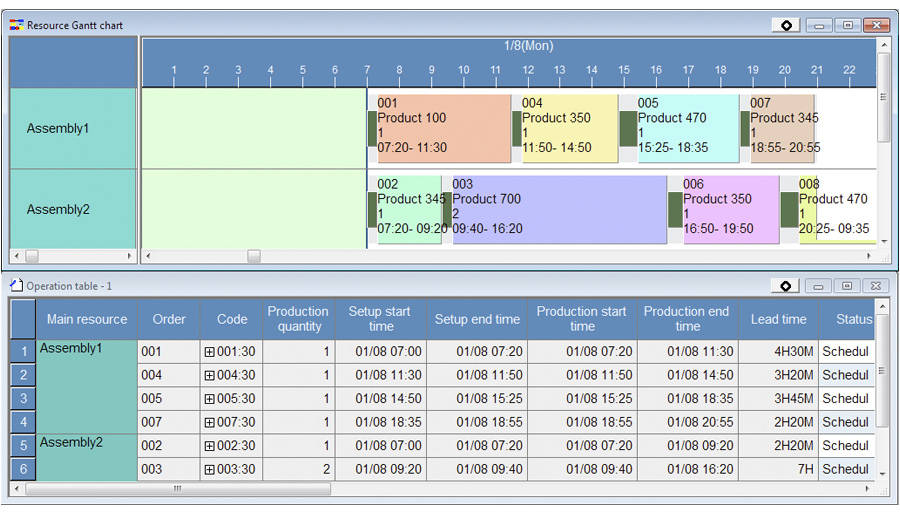Robust Model, Plan and Optimize
A pilot can only steer if the instruments display the reality.
100 % picturisation of current production in the scheduling system.
Realism and Feasibility
Forging Production Plans With Utmost Precision
- Unrealistic and infeasible schedules are a waste of time that further require additional, manual adjustments afterwards.
- In Asprova, 99.9 % of production processes, including restrictions, are mapped by adjusting existing standard parameters.
- Combined with accurate data from your side, resulting production schedules become an absolute representation of reality.
- In addition to this, Asprova plans under finite capacity on multiple levels.
- In other words: All resources, including workers and tools, as well inventory and many more are taken into account.
- The vast number of customizable standard parameters make Asprova highly flexible, as resulting schedules can be tweaked and adjusted very finely.
- Resource allocation rules, order dispatching rules and planning scenario models complete the planning process, and allow for comprehensive and meticulous crafting of production schedules.
- All resources are dealt sequentially optimized, feasible work instructions, which are a prerequisite to process synchronization.
- Based on these factors, Asprova is able to instantly calculate realistic delivery dates.

Exact advanced scheduling through 2400 parameters and 4000 properties
100 % 100 % picturisation of current production in the scheduling system.
Orders:
- Instant calculation of realistic delivery dates for specific customer inquiries (in consideration of capacities and material availability)
- Scheduling for months in advance
- Individual setting of order priority
- Automatic issuing of manufacturing order, trig- gered (in advance) by minimum stock levels of WIP or finished products
- Automatic issuing of production schedule based on sales plan
- Serving of orders from inventory, automatic issuing of manufacturing orders for missing volumes
- Dynamic handling of rush orders: calculation of effects on existing orders and simulation of deliveries to assure on-time delivery of all orders

Raw material:
- Scheduling on the basis of raw material avail- ability, i.e. no scheduling without raw material
- Consideration of the timing of incoming order- related material
- Automatic order replenishment through 1-to-1 production (flexible volume adjustment according to stock levels and fixed volumes)
- Pegging of inventory and period-specific safety stock, material constraints
- Scheduling of standardized material in- and output for weeks/months in advance
Quality:
- Setting of yield and scrap rate by product, by process and by resource in order to reach desired output volume (number of units), i.e. automatic adjustment of volume discrepancies for the first process.
Planning rules and priorities can be set individually for each order.
Over 2400 different parameters and 4000 proper- ties within the Asprova system consider all conceiv- able standard situations in production. This enables a 100% picturisation of the current manufacturing process by the software without any individual programming. The most significant parameters and setting options of Asprova:
Resources:
- Simultaneous consideration of all resource capacities for the calculation
- Simultaneous consideration of availabilities of main resources and sub-resources (e.g. machinery, right mould, left mould, workers, tools, etc.)
- Setting of resource priorities
- Timing of events (e.g. maintenance)
- Individual setting of work schedules, shifts, working days and hours, overtime and weekend hours, absences for every resource and employee
- Automatic scheduling of events, e.g. mainte- nance after a certain period of use (e.g. 2 hours after 500 hours of service), by frequency of use (e.g. 4 hours after 10,000 casts) or by fixed date (e.g. 1 hour at 7 p.m. on the last work day of the month), etc.
- Setting of productivity matrix for workers
- Skill matrix (setting of available resources and their processing speeds)
- Periods of validity (availability of resources restricted to certain times/days/periods)
- Restrictions of subsequent resources (conditions for resources conducting subsequent processes)
- Resource lock
- Configuration of resource evaluation
Processes:
- Setting of setup time (internal/ external setup, teardown) for individual machine, product, order
- Maximum/minimum periods of stagnation or transport for intermediate processes
- Allocation of splitting or merging processes
- Maximum suspends times for setup and production
- Splitting of lot sizes
- Lot merging

